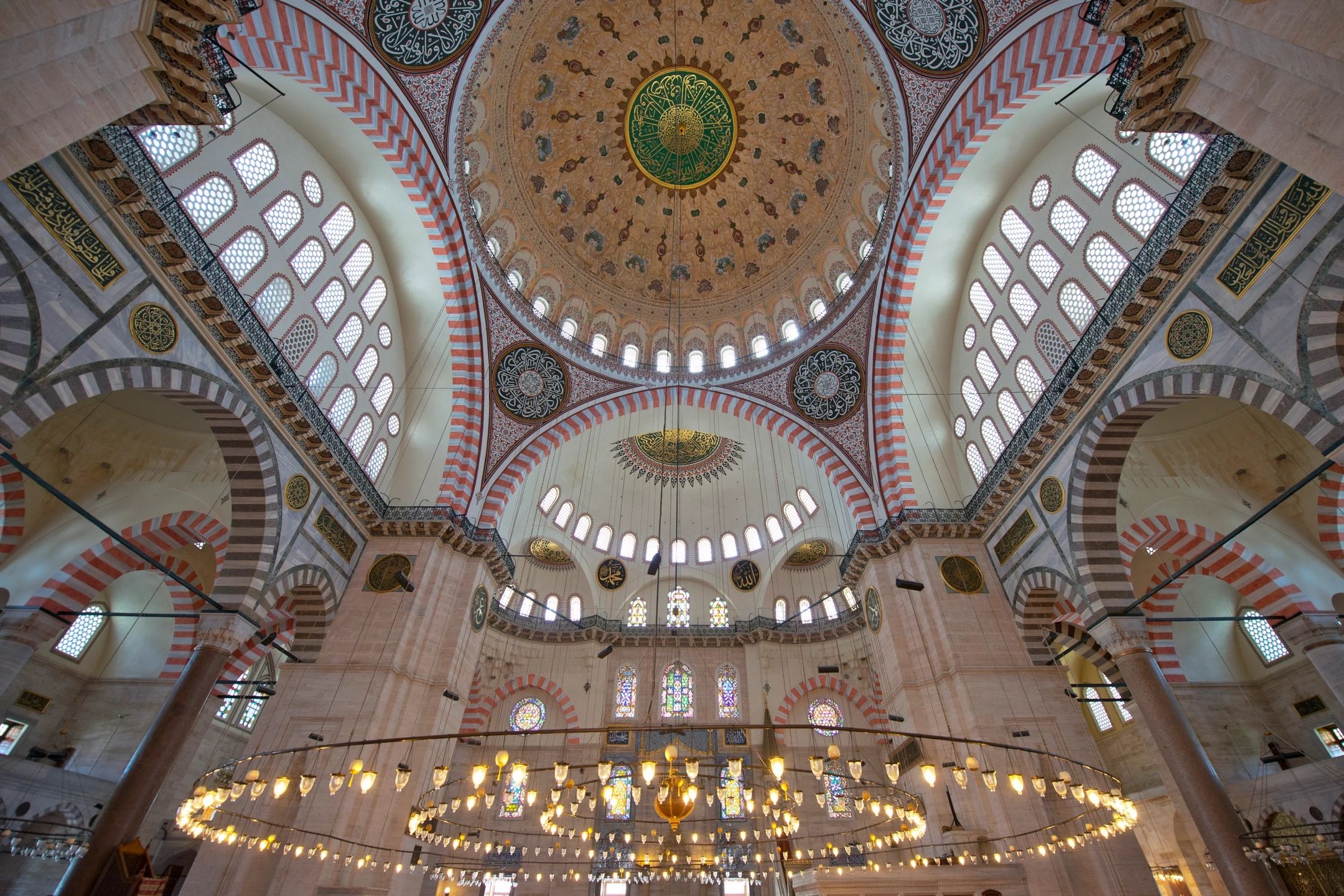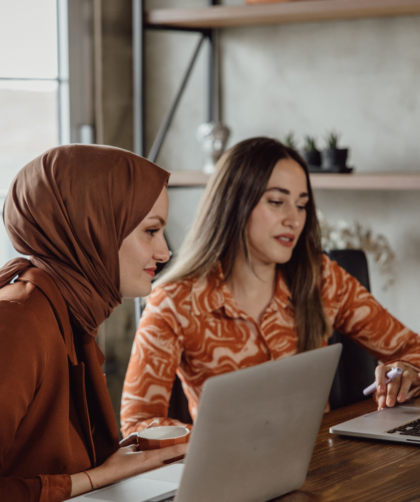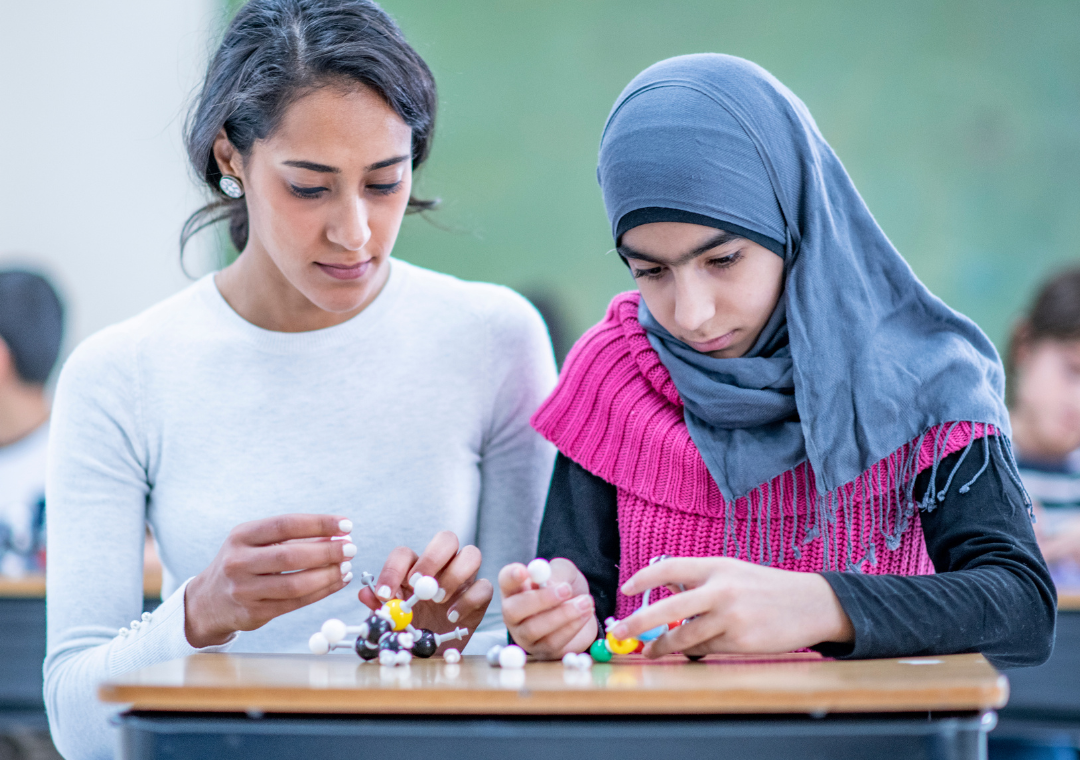Islamophobia & Accommodating Muslim Students in Higher Education
In this resource we offer teachers and non-Muslim students an insight into the experiences of exclusion that Muslim students go through in the face of an Islamophobic culture in Europe, the Netherlands, and in Western academia. The insights should offer the teachers and university staff ideas on where to begin efforts of inclusion when it comes to their Muslim students. For the rest of the readers, this resource could help you begin unpacking harmful practices that you might be part of towards your Muslim colleagues, ideally leading you to a deeper understanding of how to act more inclusively towards your peers. While it is not an extensive nor exhaustive study on the topic, it provides a collection of insights into systemic barriers for Muslim individuals in Dutch higher education.

What is Islamophobia?
Islamophobia is basically fear of Islam or anti-Muslim hate. However, there is no agreed-upon legal definition of it, nor have social scientists developed a common definition. Therefore, it is a widely used but little-understood term [1]. At least in Eurocolonial countries (or ‘Western World’), Islamophobia must be seen as a form of racism or a racist ideology. It is an ideology that attributes negative connotations to Islam and Muslims with the help of images, symbols, texts, interpretations, and actions. This ideology influences how non-Muslims (sometimes also Muslims) perceive Islam, as well as their attitudes and behavior towards it, in a way that promotes the perception of Muslims as ‘the other’, i.e. the deviation from the norm. This also includes people who are assumed to be Muslim on the basis of their appearance or ethnic origin, but who are not. Islamophobia also paints Islam as a monolithic block, static and unresponsive to change, often connoted to ‘mass migration’ as opposed to individual persons moving from one country to another [1] [2]. Islamophobic discrimination operates in cultural, social, economic, and political domains, and it involves hostility, othering, unequal treatment, and violence towards Islam, Muslims, or anyone who is perceived to be Muslim. Islamophobia is also evident through discussions and narratives about who can and cannot be Muslim based on their other identities or how they practice Islam. This happens in the Eurocolonial context as well as in Muslim-majority cultures. It is important to add here that challenging someone’s Muslim-ness because of their LGBTQIA+ identity, their choice of wearing a headscarf or not, or whether they are a convert is also Islamophobic.
Islamophobia is not only racism but Islamophobic dimensions of discrimination are also often interwoven with other dimensions like origin, ethnicity, (different modalities of) migrational status, and gender. These intersectionalities, especially in the Dutch context, are further discussed below. Moreover, it is important to note that Islamophobia is similar to other forms of racism such as anti-semitism or Antiziganism, which is directed at Roma and Sinti [2].
Finally, we should make a distinction between religious criticism and Islamophobia, especially in the Euro-colonial context. Pooyan Tamimi Arab from the University of Utrecht’s Religious Studies Department suggests the following question in doubt: are you critical of a body of thought or of a deviation from the norm? [6]
Islamophobia in the Netherlands
Islam in the Netherlands is not a new phenomenon, but Islamophobia is rising. Islam is somehow seen as new, foreign, strange, and, in the worst-case scenario, downright dangerous. Its history in the Netherlands dates back to the 16th century when Ottoman merchants began settling in the port cities. In the 19th century, the Dutch ruled Indonesia, a majority-Muslim country with the largest Muslim population in the world. Finally, in the post-WW2 era, the Netherlands needed a larger workforce for various sectors due to the swift industrial growth, and work-based immigration from Muslim-majority countries like Turkey, Morocco, Tunisia, and Algeria took place in the 1950s and 1960s. Today, at least 5% of the adult population in the Netherlands is Muslim [19], even though the general public tends to overestimate (selective perception and over-exposure in media) or underestimate (an ignorable deviation from the norm, i.e. Christians) this number.
Compared to other ‘Western nations’, the Dutch have a relatively low opinion of Muslims: 50% of the population hold negative views on Muslims compared to the United Kingdom’s 14% and the United States 22%. On the other side of the coin, one in three Muslims of Turkish or North African origin in the Netherlands report having experienced discrimination on the grounds of religion or ethnic origin [2].
The scholar and author Ineke van der Valk points out that in recent years, there has actually been a deterioration rather than an improvement in the climate of opinion in the Netherlands. Muslims are becoming increasingly isolated, negatively portrayed, and depicted as ‘enemies of society’, especially on the Internet, by the right-wing Freedom Party (PVV), and by the steadily growing anti-Islamic attitude in the extreme right-wing movement. A strong feature of the PVV is its Islamophobic discourse which describes Islam as a violent ideology and makes no distinction between Islam and extremist Islam [2]. PVV increasingly becoming a more predominant voice in the political discourse is definitely one of the factors explaining the rise of anti-Muslim and anti-immigration sentiment in the Netherlands.
Islamophobia in the Dutch context cannot be understood in a vacuum and has to be analyzed through an intersectional lens. For starters, Islamophobia is closely linked to racism, even though religion and nationality/ethnicity are separate things. In the Netherlands, the research on racism and discrimination makes a distinction between non-Dutch groups: from so-called Western countries versus from non-Western countries. This distinction stems from the vastly different attitudes in Dutch society towards the two groups. The non-Western group experiences more discrimination and racism. Muslims generally fall automatically under the latter category. The last layer of these intersecting categories of inequality is Muslim women wearing headscarves. They experience considerably more discrimination on the basis of religion than women who do not wear a headscarf.
Here are some staggering statistics: 11% of Afghani-Dutch Muslim women not wearing a headscarf report having experienced Islamophobic discrimination compared to 73% of Afghani-Dutch who do wear a headscarf. For Iraqi-Dutch these figures are 9% versus 45%, for Iranian-Dutch 8% versus 45%, for Somali-Dutch 20% versus 49%, for Moroccan-Dutch 15% versus 39%, and for Turkish-Dutch 14% versus 55%. This clearly suggests that Muslim women with a migration background wearing Islamic dress are directly and systematically discriminated against [5].


Another example is the labor market. Muslim women with headscarves experience discrimination more than others when applying for jobs. An experiment conducted in 2022 used CVs with the same content and information but with veiled or unveiled photos. The results in the Netherlands showed that 35% of women with headscarves got responses from employers, while this rate rose to 70% among those not wearing them. It is also not about a preference for religious neutrality, instead of a bias against Muslims. They find no penalty for volunteer work at a Christian association but a significant penalty for the same work at a Muslim association. Di Stasio, one of the authors of the study, remarks that downplaying ethnic and religious cues on CVs increases the chance for a callback, however, it comes at a high personal cost: an individual’s right to be their authentic self [3] [20]. Geert Wilders, leader of the right-wing Freedom Party (PVV) captured the public debate in 2009 by advocating for a special tax on headscarves. Wilders’s proposal was never translated into policy, but it did capture the imagination of Dutch society and has been an important marker in the public framing of headscarves. In conclusion, it is essential to acknowledge that Muslim women endure multiple and unique problems because of the intersection of their gender, ethnicity, and religion in Dutch society. Therefore, solutions proposed to combat Islamophobia cannot have a generic and ‘gender-neutral’ approach to emancipation and should include focussed attention on the unique position and experiences of Muslim women [5].
Islamophobic discrimination in the Netherlands is systemic and commonplace. A 2014 Netherlands Institute for Social Research report on experiences of discrimination amongst the Dutch population found that 46% of Muslims had experienced being discriminated against on the basis of their religion in the twelve months prior to the research being conducted. Furthermore, 65% of Muslims said they had felt discriminated against on the basis of religion or other grounds [5]. Leaflets bearing anti-Muslim sentiments were distributed in Rotterdam, Den Bosch, and in the northwest of the country, and were also seen in Amsterdam, and racist graffiti was targeted at mosques, Islamic schools, and Muslim-owned shops [1] [24]. An enormous body of research, reports, and anecdotal evidence collected by anti-discrimination organizations show that Islamophobia affects all arenas of life in the Netherlands: violence in the form of hate crimes and hate speech, protests against mosques, housing inequality, discrimination in the job market, segregation of education, and mainstream media & social media.
Cases of Islamophobic hate crimes and hate speech, and violence against Muslims and mosques remain highly under-reported in the Netherlands. Almost 40% of the Netherlands’ 475 mosques have experienced at least one incident of Islamophobic violence from 2005 to 2015. Amongst them are leaving body parts and the insides of dead sheep and pigs at the mosque doors, vandalizing the walls with racist graffiti and Neo-Nazi symbols, smashing mosque windows, attempting arson, sending threatening emails and letters [2] [22] [24] [25]. A study highlights that mosques that are easily recognised due to their minarets or domes are more likely to be targeted than those that stand out less. This further proves that these hate crimes are not random acts of violence, but they deliberately target mosques and Islam. Unfortunately, only a limited number of these criminal cases are solved, and perpetrators are caught. Solved cases, however, involved groups of youths with ideological motives [2].
In 2016, in Enschede, a 33-year-old man threw a petrol bomb at a mosque where adults and children were praying [25]. However, this attack was not mentioned in the annual report of Algemene Inlichtingen- en Veiligheidsdienst (General Intelligence and Security Service). This indicates that violence perpetrated against Muslims is deemed less socially disruptive than violence perpetrated by Muslims [7]. Despite all the evidence of Islamophobic hate crimes taking place in the Netherlands, the image of a ‘terrorist’ in white Dutch people’s imagination is still a dark-skinned Muslim man and not a blonde Dutch boy.
The ‘non-violent’ acts against the establishment of mosques, on the other hand, take the form of protests usually initiated by local residents, but nearly one-third of them are the work of extreme right-wing groups. Even though the protesters complain about the parking difficulties and noise nuisance, it is never the real reason behind protests against mosques. Because these protests only happen only in cases where the building of a mosque is being proposed. Moreover, in recent years, the PVV has taken more political steps to prevent the building of mosques [2].
In the Netherlands, it is illegal for employers to discriminate on the basis of race, religion, or the wearing of religious symbols [27]. However, people with migrational backgrounds are overrepresented in terms of unemployment (16% of people of migrant descent were unemployed in 2005 in contrast to 6.5% of the total labor force) [1]. Another employment-focused research with 34 large companies and interviews with experts estimates that only 1-2% of these top positions are held by someone with a non-western migration background [5]. In job interviews, Muslims face ‘completely irrelevant questions’ like their thoughts on terrorism, gender relations, LGBTQIA+ issues or their loyalty to the Netherlands. Avoiding these questions or confronting the interviewer in most cases is not easy, because doing so might cost the applicants their chance of getting the job. Also, if they complain, they might be accused of not being able to take a joke or ‘playing the racism card’ [19].
Moving onto education, pupils with a migrational background have lower literacy and mathematics scores than pupils with no foreign background. The reason behind these troubling differences is the possibility of discriminatory practices. Despite the similarity of the educational histories of the two groups of pupils, being a migrant pupil leads to a relative disadvantage. Education-related complaints to relevant agencies are regarding admissions, policy measures, and relations between pupils, teachers, and parents.
In the Netherlands, the most alarming problem in education is increasing ethnic segregation in schools, it cannot be overlooked. Even though the data showcasing this segregation is not based on religion, migration-based segregation is a good indicator of Islamophobia and other religion-based discrimination taking place at the schools. The number of primary schools with at least 70% ethnic minority students rose from 129 in 1986 (of the 8,300 total) to 343 in 2003 [1]. Generally speaking, one-third of primary schools do not reflect the social composition of the local district. Pupils with and without immigrant origin are not evenly distributed across the schools. This is partially related to housing segregation and to what is known as ‘white flight’. Some Dutch parents deliberately send their children to schools with no or very few children with migrational backgrounds [2][18]. Although ethnic segregation in education goes against the Dutch Equal Treatment Act, schools keep finding ways to revert to such measures, for example, by introducing waiting lists for ethnic minority pupils [1]. Another example is a public primary school in Ede which denied non-Western migrant families access to the school following a renovation project [2].
Another area where we see more Islamophobia is in the media, especially on the internet and social media. The depiction of Muslims and Islam in the media is described as stigmatizing and unbalanced following the deteriorating tone of public debates on migration issues in the Netherlands. Controversial websites such as GeenStijl and Powned use Islamophobic language and play a role in the rising anti-Muslim sentiment. They depict Muslims as political or cultural threats and frame Islam as underdeveloped and backward [23]. On social media, Muslims have to deal with hate speech regularly. Some develop a thick skin and try to ignore it, while others find it difficult to do so. How Muslims are portrayed in the mainstream and right-wing media unfortunately also contributes to a negative self-image [21].
After the Second World War, Europe was very motivated to resist the dangers of fascism, racism, and discrimination. This resulted in anti-discrimination policies being firmly embedded in legislation in the Netherlands. However, this motivation might be coming under pressure because of the growing Islamophobic ideology in the country. In the Netherlands, the number of violent acts against Muslims and mosques is higher than in other countries. Muslims are often portrayed unfavorably in the political discourse. Islamophobia can be found on the Internet, in politics, in employment and education, and in acts of violence committed against mosques [2].
Islamophobia in Academia
The rise of Islamophobia in ‘the West’, sometimes also operating in a subtle and discreet fashion through microaggressions, has been affecting higher education as well. Universities are supposed to be culturally inclusive and egalitarian spaces, however, Muslim students are increasingly experiencing thinly veiled occurrences of ‘othering’ and marginalization [15]. Microaggressions relating to their appearances, hypervisibility, perpetrators maintaining excessive distance, peculiar staring, and hurling racial jokes are the most common examples. The accumulation of Islamophobic prejudice takes its toll on students as they develop mental health problems [16]. Islamophobia at the universities and elsewhere undermines the ability of Muslims to be Muslims [13]. Observing prayer and religious periods/holidays are often perceived as non-negotiable and constitute a fundamental element to the everyday lives of many Muslims [14][15]. Therefore, limitations to expressing one’s unique self and a lack of belonging, exclusion, declining mental health, burnout, deteriorating academic success, and even turnover are among the effects of Islamophobia on Muslim students.
Specifically in Dutch academia, the data on Islamophobia and the domain of education does not generally differentiate between higher education and tertiary education. According to a 2020 research conducted with Turkish-Dutch and Moroccan-Dutch people, 22% of pupils and university students have experienced discrimination in education in the past twelve months and a further 8% doubted whether an incident was discrimination. Almost 3% of all pupils and students in the Netherlands indicate that they have stopped their education as a result of discrimination [9][12]. A 2019 report by ‘Meld Islamophobie’ further showcases that Dutch academia is in no way immune to Islamophobia. Students and staff alike experience discrimination, stigmatization, and anti-Muslim hate. The report mentions two real-life examples.
First, in the run-up to the municipal elections of 2018, the PVV campaign video appeared during the broadcasting time for political parties. The video was full of anti-Muslim sentiment and fearmongering. A participant of the report recounts an online discussion on their university’s web page where people started defending the video and trying to bring down Islam. The participant says that it was very hurtful and difficult to deal with.
Another participant who works at a university says that her colleagues do not know that she is Muslim. Even the professors and administrators say the most unbelievable things such as: "We now have a hijabi secretary" or "Look, another one has started wearing a headscarf". Since then she cannot decide whether or not to wear a hijab because she is afraid that neither her colleagues nor the students will take her seriously as an academic. “The feeling of not being able to express my faith freely is oppressive.” the participant concludes. [4]
Physical limitations to prayer spaces also pose significant barriers for Muslims and students of other religions. According to a research in 2021 done with students from the Netherlands, even when there are designated areas for prayer, there is usually just one and students struggle to run between classes and often feel it is still inaccessible. Additionally, due to overarching anti-Muslim sentiments (microaggressions and covert forms of negative attitudes), students do not feel at ease practicing in public, an action that could be of use if they are running late for a class or an exam [28]. Additionally, while secularity is at the supposed forefront in public institutions in the Netherlands, it still preaches Christian normativity. This shows up as having the official holidays be the Christian ones and an inability to take time off during non-Christian holidays. Even if teachers, mentors, and employers can compromise and allow students to celebrate and observe their holidays, this is usually on an individual basis. Likewise, exams are placed in a way to skip Christian holidays but do not regard non-Christian ones, leaving it up to chance if non-Christian students and staff can or cannot take the time to observe them. In this way, Muslim students have to go out of their way to accommodate themselves in a culture that promotes Christianity under secularity pretenses [28].
In the same study, Muslim students express fear and discomfort with wearing religiously-associated symbols, such as hijabs, as they sense discomfort and unease from teachers and classmates. They feel a sense of overexposure in an Islamophobic context which creates to daily feelings and experiences of exclusion and alienation.

On the brighter side of it, critical discussions regarding the Muslim experience and Islamophobia in the Netherlands, as well as at the universities are taking place. In 2017, a meeting was held at the University of Amsterdam on the normalization of Islamophobia. The event problematized that statements such as 'Islam is a threat to Dutch identity' or 'The Netherlands must close its borders to Islamic migrants' are commonplace in the election debates and not only part of the right-wing extremist discourse. Organized by Collectief tegen Islamofobie en Discriminatie (Collective against Islamophobia and Discrimination), the event aimed at shedding light on the topic and discussing what to do to combat Islamophobia. Among the speakers were Islamophobia scholars Martijn de Koning and Ineke van der Valk, and sociologist Ibtissam Abaâziz from the Meld Islamophobia. [7]
How can universities & staff accommodate Muslim students?
Author/Project Lead: Ekin Yıldıran-Schoepe
Co-editors: Alex Alexandrova & Francis Urciullo
Academic Sources & Reports:
[2] van der Valk, I. (2012). Islamophobia in the Netherlands. Pallas Publications Amsterdam University Press: Amsterdam.
[3]Fernández-Reino, M., Di Stasio, V., & Veit S. (2022). Discrimination Unveiled: A Field Experiment on the Barriers Faced by Muslim Women in Germany, the Netherlands, and Spain. European Sociological Review.
[5]https://www.enar-eu.org/wp-content/uploads/factsheet_netherlands_-_en_final.pdf
[6]https://www.uu.nl/in-de-media/waar-ligt-de-grens-tussen-islamofobie-en-religiekritiek
[8]https://www.republiekallochtonie.nl/blog/feiten/factsheet-moslimhaat-en-moslimdiscriminatie
[12]https://www.scp.nl/publicaties/publicaties/2020/04/02/ervaren-discriminatie-in-nederland-ii
[13] Sayyid, S. (2014) A Measure of Islamophobia. Islamophobia Studies Journal, 2 (1), pp. 10-25. Retrieved from https://eprints.whiterose.ac.uk/83697/1/Sayyid%20A%20Measure%20of%20Islamophobia-%20journal%20version.pdf
[14] Akel, S. (2021) Institutionalised: The Rise Of Islamophobia In Higher Education. London Metropolitan University.
[15]https://communitypolicyforum.com/responding-to-islamophobia-in-the-academy/
[16] Chaudry, I. (2021) “I Felt Like I Was Being Watched”: The Hypervisibility of Muslim Students in Higher Education. Educational Philosophy and Theory, 53 (3), pp. 257-269.
[17] Akel, S. (2021). Institutionalised: the rise of Islamophobia in higher education. Project Report. London Metropolitan University, London. Retrieved from https://www.londonmet.ac.uk/media/london-metropolitan-university/london-met-documents/professional-service-departments/centre-for-equity-and-inclusion/research-reports/Institutionalised--%C3%82%C2%A0The-Rise-of-Islamophobia-in-Higher-Education.pdf
[18] Ridder, J. den, E. Josten, J. Boelhouwer, & C. van Campen (2020). De sociale staat van Nederland 2020. Den Haag: Sociaal en Cultureel Planbureau (SCP).
Newspaper Articles:
[19]https://www.aa.com.tr/en/europe/islamophobia-becoming-normalized-in-dutch-society-study/2508168
[22]https://nltimes.nl/2016/03/01/violence-muslims-mosques-largely-unreported
[25]https://www.aljazeera.com/features/2016/3/16/netherlands-mosque-attacks-and-rising-islamophobia
[28] Alexandrova, A. (2021). Fighting Systemic Racism and Discrimination in Higher Education. [Unpublished manuscript].





